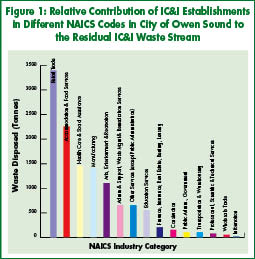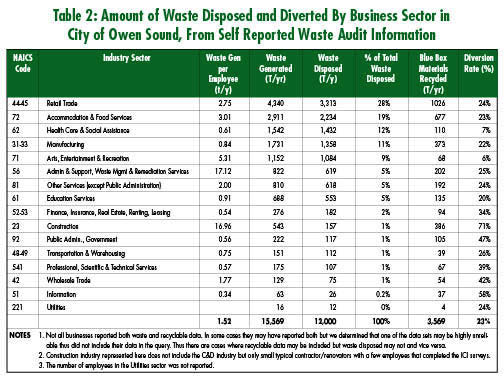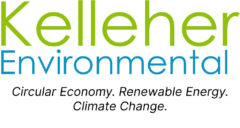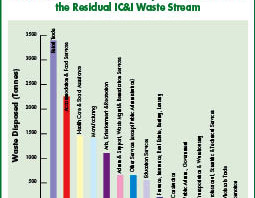Owen Sound study indicates who produces what (and what happens to it)
By: Maria Kelleher
Solid Waste & Recycling Magazine – 2010-04-01
They say you need good information to develop good policy…
One of the challenges dogging policy development for industrial, commercial and institutional (IC&I) waste and in assessing the effectiveness of existing policies and regulations is the lack of detailed data on which businesses or business groups produce the most waste, and how business size affects the amount. In the February/March edition (see Cover Story) we looked at the picture from a macro perspective. Now we turn to a key question: To what extent do small businesses contribute to the tonnages tonnes of non-residential waste disposed in Canada each year?
Without this information it’s difficult to develop an effective policy for IC&I waste diversion and (importantly in the policy development stage) it’s hard to know how effective policies that focus waste generator types will be.
Policymakers intent on reducing IC&I waste sent for disposal need to figure out how to address the waste coming from small businesses. While each individual small business might generate a small amount of IC&I waste, collectively (because of their large numbers) they may contribute a sizeable portion of the total.
Owen Sound
The City of Owen Sound in Southern Ontario has a population of about 22,000 – with an additional 10,000 living in the surrounding area. The city instituted a mandatory recycling by-law in 2006 requiring all IC&I establishments to submit a waste audit report identifying the amount of waste produced, diverted and disposed.
Data from 687 waste audit reports submitted by all businesses in the city were entered into a custom designed database and analyzed. Information on waste density, and the quantities of waste and recyclables generated by Owen Sound businesses, was provided to Kelleher Environmental by Miller Waste, a waste management company that collects most of the IC&I waste from the city’s businesses, and that operates a transfer station in through which most Owen Sound IC&I waste passes.
The database sorted the information by size of company (measured as number of employees) as well as by NAICS Code (a coding system for different business categories).
 Table 1 shows the volume of waste disposed and diverted by companies of different sizes in Owen Sound:
Table 1 shows the volume of waste disposed and diverted by companies of different sizes in Owen Sound:
• About half of the disposed waste is from companies with less than 20 employees;
• 30 per cent of the disposed waste is from companies with greater than 50 employees; and
• the remainder (20 per cent) is from companies with 21 to 50 employees.
Based on the self-reported data submitted by almost 700 businesses of all sizes in the city, the overall diversion rate for IC&I waste is about 24 per cent. This is in contrast to the 11 per cent figure reported by Statistics Canada in the most recent WMIS survey. It should be noted that in an ideal world, the self-reported figures should be verified through site visits to each business, or a selected number of businesses. However, for a city of just 20,000 residents, this would involve almost 700 site visits, and a prohibitive investment in time for current purposes.

Table 2 shows the data collected by industry type, using the NAICS classification system. The study database calculated by NAICS code the waste generation per employee, total waste generated, blue box materials recycled, and waste disposed, based on self reported audits by City of Owen Sound businesses.
The table shows that key contributors to the residual IC&I waste stream in Owen Sound are:
• Retail 28 per cent;
• Accommodation and Food Services 19 per cent;
• Healthcare 12 per cent; and
• Manufacturing 11 per cent.
Together, these four sectors contribute to 70 per cent of the residual IC&I waste stream.
The data provides a very valuable dataset for IC&I waste management planning, as all businesses in the city (regardless of size or the business involved) were required to submit a waste audit report.
The City of Owen Sound therefore provides an excellent opportunity to see how the business mix of a typical small city contributes to the IC&I waste produced, and therefore identify the diversion opportunities available. It’s particularly valuable as most of the businesses in Owen Sound are small (almost half have five employees or less), and there are virtually no data available on the extent to which small companies contribute to the overall IC&I waste stream.
The key question now becomes: If at least half of the IC&I waste generated in a typical city or community comes from small businesses, what is an effective strategy or policy to encourage IC&I waste diversion?
Mandatory recycling ordinances are one effective way to increase diversion by IC&I generators. However, they need to be enforced, and markets need to be available or developed, for the additional material recovered.
Landfill bans on recyclable materials or surcharges on loads with high recyclable material content have been implemented in some locations. These “end of pipe” policies put the onus on haulers to ensure that their clients are recycling the banned materials.

